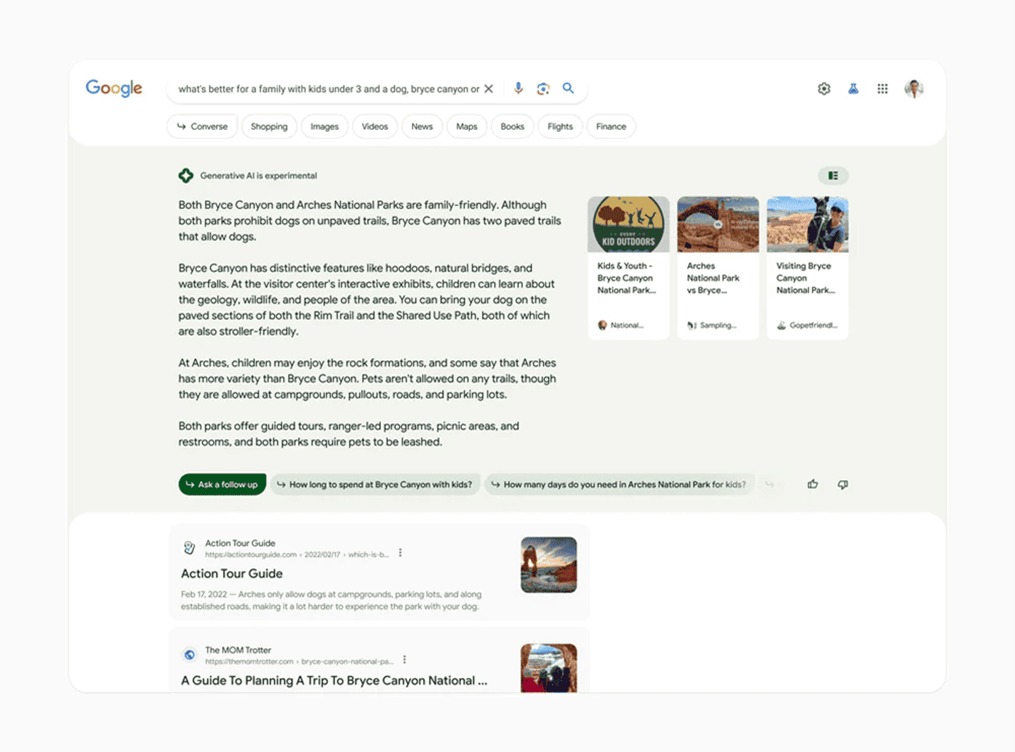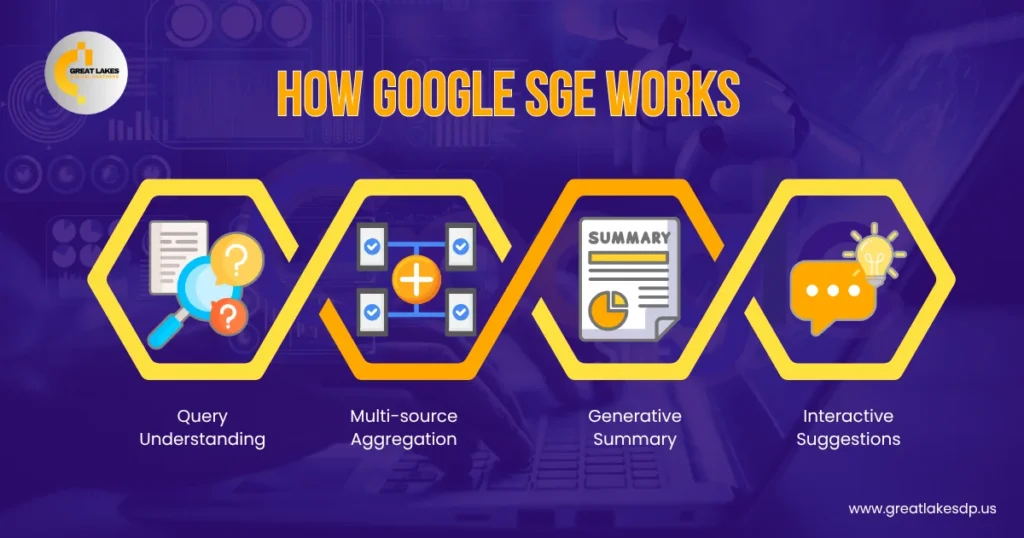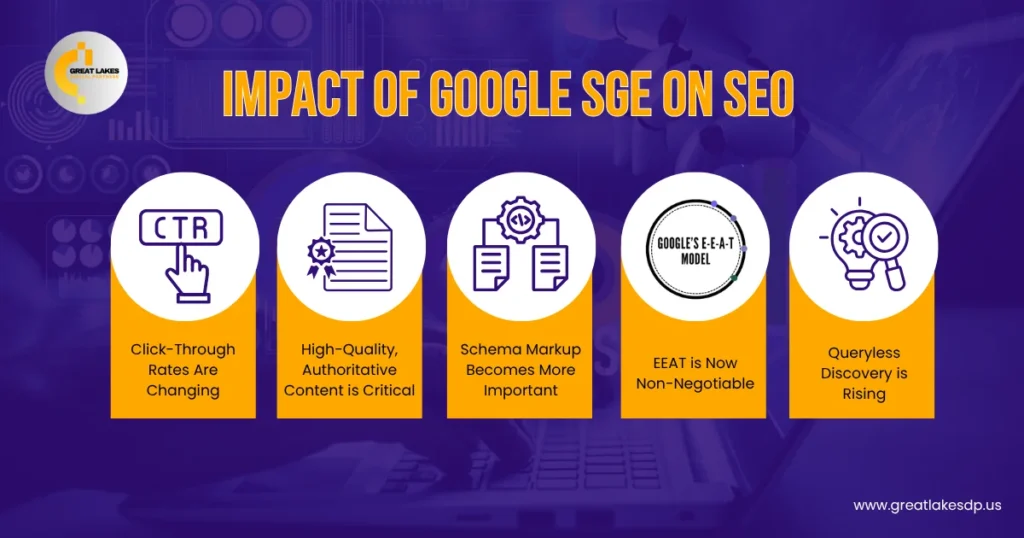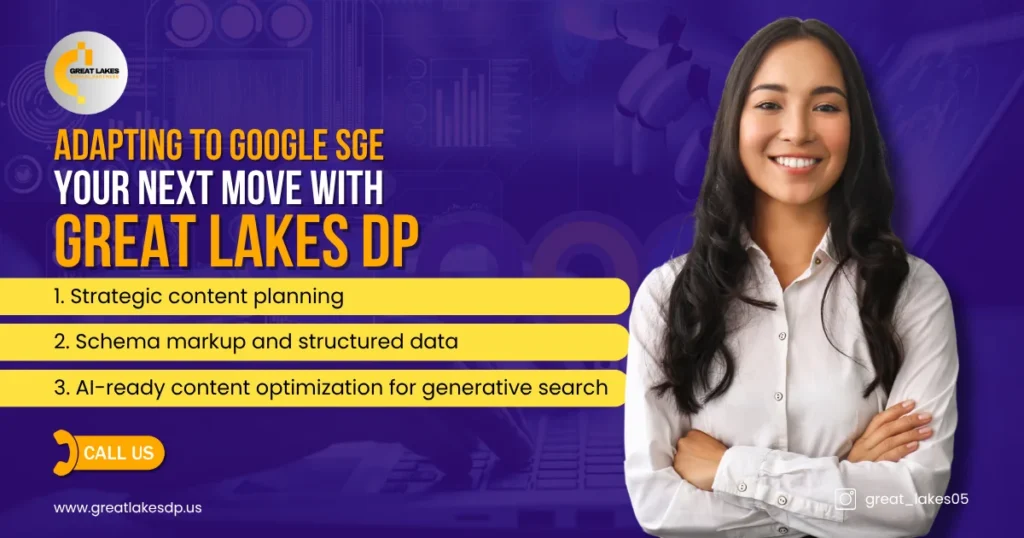The way we search online is undergoing a major transformation. In 2024, Google introduced something groundbreaking Google SGE, or Search Generative Experience. Powered by generative AI, Google SGE is not just a tweak to the traditional search results; it’s a whole new way of interacting with information.
But what exactly is Google SGE, how does it work, and why should you care? Most importantly, how will it affect your website’s visibility, traffic, and SEO strategy in 2025?
In this blog, we’ll break down Google SGE in a way that’s easy to understand. Whether you’re a business owner, content creator, or SEO professional, this guide will equip you with the knowledge you need to adapt and thrive in the era of Google SGE.
Table of Contents
ToggleWhat is Google SGE?

Google SGE (Search Generative Experience) is an experimental feature powered by generative AI and large language models (like PaLM 2 and Gemini). Instead of just showing blue links on a results page, SGE provides AI-generated overviews that summarize key answers at the top of search results.
These overviews often include:
- Summarized content generated by AI
- Follow-up questions to continue exploring
- Key web links cited as sources
- Product recommendations with purchase options
Essentially, Google is becoming more of a conversation partner than just a results provider. And that changes everything.
How Google SGE Works

Here’s how it functions under the hood:
- Query Understanding: Google’s AI breaks down the search intent behind your query.
- Multi-source Aggregation: It scans content from across the web and identifies the most relevant and credible information.
- Generative Summary: Using generative AI, Google creates a concise, human-like answer, often shown as a colorful box at the top of the page.
- Interactive Suggestions: It offers related follow-up questions or refinements for deeper discovery.
The goal? Save users time and effort by giving them an answer without needing to click through multiple pages.
How to Turn On Google SGE
As of mid-2025, Google SGE (Search Generative Experience) is still an experimental feature, available to users in select countries through Google Search Labs. If you want to explore how SGE works firsthand, here’s how you can enable it:
On Mobile (Android or iOS)
- Open the Google app on your smartphone.
- Tap the “Search Labs” icon (a beaker or test tube) at the top-left corner. If you don’t see it, update your app or check if it’s available in your region.
- Find the toggle for “SGE” or “Search Generative Experience”.
- Switch it ON.
- Read and accept the terms, then start exploring SGE-powered results.
On Desktop
- Go to labs.google.com/search.
- Log in with your Google account.
- If eligible, you’ll see an option to enable Search Generative Experience.
Toggle it ON and confirm your participation.
Why Google Launched SGE
Google SGE is a direct response to the rising popularity of AI assistants and the success of platforms like ChatGPT and Perplexity.ai Users today expect answers fast, and Google is adapting by delivering value right within the search itself.
But that also means one thing: less traffic to websites if your content isn’t part of the AI answer.
This is where the seismic impact of Google SGE on SEO begins to reshape the landscape of traditional search strategies.
Impact of Google SGE on SEO

Let’s get to the part everyone’s talking about, how does Google SGE affect SEO?
1. Click-Through Rates Are Changing
Pages not cited in AI overviews may experience lower CTRs even if they rank on page one. Being “position zero” is the new goal – but now, it’s AI-chosen.
2. High-Quality, Authoritative Content is Critical
Google SGE favors trustworthy sources. If your content lacks depth or credibility, it may never be selected in AI summaries.
3. Schema Markup Becomes More Important
Structured data helps Google understand your content better. Sites with rich schema (FAQs, how-tos, reviews) are more likely to be referenced by the generative AI.
4. EEAT is Now Non-Negotiable
Google continues to emphasize Experience, Expertise, Authoritativeness, and Trust. The AI algorithms are trained to prioritize content that reflects strong EEAT signals.
5. Queryless Discovery is Rising
With SGE, search is becoming more proactive. Users are exploring through questions and follow-ups. This means your content needs to support long-tail queries and conversational language.
If your SEO strategy hasn’t evolved yet, now is the time.
How to Optimize for Google SGE
To stay relevant in this new AI-powered era, follow these steps:
1. Create Deep, Well-Structured Content
Surface-level content won’t cut it. Answer user queries in-depth, with subheadings, lists, examples, and clear language.
2. Use Conversational Long-Tail Keywords
Google SGE thrives on natural language. Focus on how real people ask questions, not just how machines read keywords.
3. Add Schema Markup
Use structured data for FAQs, product reviews, how-to guides, and more. This increases your chances of being cited in AI-generated summaries.
4. Demonstrate EEAT
Add expert bylines, cite data sources, link to credible studies, and keep your content regularly updated. Google’s generative AI values authority.
5. Monitor SGE Performance (When Available)
Google is slowly rolling out SGE analytics. Stay updated with tools like Search Console and third-party platforms that track generative snippets.
SEO Companies Are Adapting Fast – Are You?
If you’re a business in Michigan or anywhere else, now is the time to partner with an SEO Company in Michigan that understands the nuances of Google SGE. This isn’t just about rankings anymore – it’s about visibility in the age of AI.
Leading agencies are now building strategies specifically tailored for Google generative search. They’re focusing on structured data, AI-friendly content, and smarter keyword targeting.
What is Google SGE in Simple Terms?
Google SGE (Search Generative Experience) is an AI-powered feature in Google Search that gives you instant, summarized answers to your queries using generative AI. It saves time by pulling information from across the web into a short, helpful snapshot right on the search page.
Adapting to Google SGE: Your Next Move with Great Lakes DP

Google SGE is more than a feature update, it’s a complete shift in how people discover information online.
Businesses that adopt smart, AI-aware SEO strategies now will lead the digital race tomorrow.
Great Lakes DP helps Michigan-based businesses stay ahead of this curve.
Our expertise covers:
- Strategic content planning
- Schema markup and structured data
- AI-ready content optimization for generative search
We don’t just improve rankings — we future-proof your entire SEO ecosystem.
FAQs About Google SGE
1. Will Google SGE completely replace traditional search?
Not immediately. Google is still testing SGE as an experimental feature, and traditional results remain. However, it’s likely to become a core part of the search experience.
2. How can small businesses benefit from Google SGE?
By focusing on long-tail keywords, local SEO, and expert-driven content, small businesses can become featured sources in AI-generated answers and gain early-mover advantage.
3. Does SGE affect all industries equally?
No. Industries like healthcare, finance, tech, and ecommerce are more heavily impacted due to higher query volumes and demand for authoritative answers.
4. Can I track traffic from Google SGE?
Currently, Google is slowly rolling out reporting tools for SGE impressions and click data. Until then, SEO experts recommend monitoring CTR trends via Search Console.
5. Is PPC impacted by Google SGE?
Yes, paid search placements may shift or reduce in visibility depending on how Google integrates ads into the generative experience. Watch for new formats and placements in 2025.
6. What’s the best content format for Google SGE?
Listicles, how-to guides, expert Q&As, and detailed blog posts with schema markup perform well. Use headers, bullets, and data citations to make your content AI-friendly.
7. Should businesses rewrite old content for SGE?
Absolutely. Update existing content with structured data, refreshed stats, deeper insights, and conversational tones to improve its chances of being selected by Google SGE.


